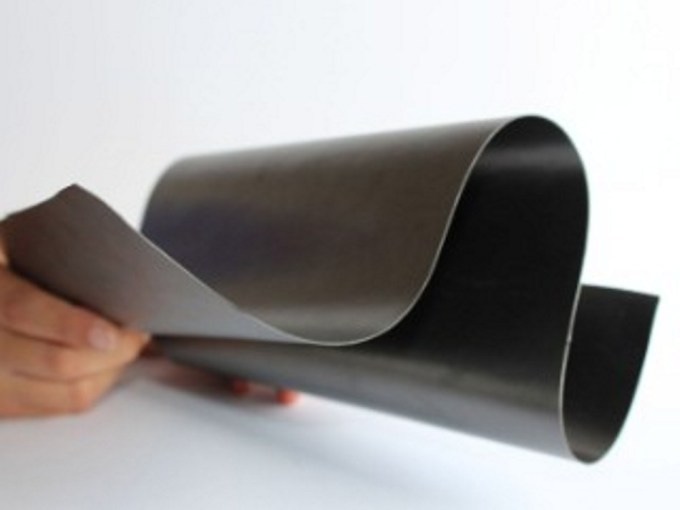Jan 25 2019
The present generation of battery systems, whether utilized in electric cars or for power supply, is based on a sequence of individual interconnected cells, which have a number of drawbacks in terms of manufacturing and efficiency. On the other hand, bipolar battery setups contain compact stacks of separate cells.
 Highly flexible bipolar plate. (Image credit: Fraunhofer UMSICHT)
Highly flexible bipolar plate. (Image credit: Fraunhofer UMSICHT)
Now, batteries can be produced cost-effectively through a new type of extremely thin and flexible bipolar plate. Scientists from the Fraunhofer Institute for Environmental, Safety and Energy Technology UMSICHT will present the development of this novel technology at the Hannover Messe Preview to be held on January 24th, 2019 at Hall 19, and at the Hannover Messe itself from April 1st to 5th, 2019 at Hall 2, Booth C22.
Traditional battery systems are known to be highly complex and often contain a number of separate cells that are joined with one another through wires. However, this is not only expensive and time-intensive but also involves a significant risk of hot spots—areas wherein the wires become extremely hot. Moreover, it is essential to package each one of these cells, which means a major part of the battery contains inactive material that does not add to the performance of the battery.
This problem can be solved with bipolar batteries—that is, using flat bipolar plates to connect the individual cells with one another. Yet, this method presents other kinds of challenges—either the bipolar plates are made of a carbon-polymer composite, which means they need to have a minimum thickness of several millimeters due to the production process, or they are made of metal and hence can corrode easily.
Material savings of more than 80 percent
At the Fraunhofer Institute for Environmental, Safety and Energy Technology UMSICHT in Oberhausen, researchers have come up with an alternative.
We manufacture bipolar plates from polymers that have been made electrically conductive. In this way, we can produce very thin plates and – compared with conventional cells connected by wires—save over 80 percent of the material used.
Dr-Ing. Anna Grevé, Department Head, Fraunhofer UMSICHT.
The material also provides a number of other benefits, for example, it is not prone to corrosion. Another significant benefit of this material is that it can be subsequently remolded, making it possible, for instance, to emboss structures, which are crucial for fuel cells. Furthermore, the novel bipolar plates can be fused together, and therefore the ensuing battery system is completely tight. By contrast, traditional bipolar plates are not appropriate for welding because the material is thermally and mechanically stressed at the time of the manufacturing process. Seals are required to fuse them in such a way that neither liquids nor gases can penetrate through the joints. Conversely, seals not only take up space but also become porous quickly. An additional benefit of the novel material is that the investigators can customize the characteristics of the bipolar plates to particular needs. “We can make plates that are so flexible that you can wrap them around your finger, as well as ones that are completely stiff,” specified Grevé.
Cost-effective manufacture through roll-to-roll technique
The main challenge involved the development of the material and the production process. “We use commercially available polymers and graphites, but the secret is in the recipe,” stated Grevé.
Since the material contains just around 20% polymer and approximately 80% graphites, the processing techniques are completely different from normal polymer processing. At Fraunhofer UMSICHT, the research team selected the roll-to-roll technique and customized it using plenty of experience. This technique enables low-cost manufacturing. In any case, the ingredients that are used in the fabricated plates should be uniformly distributed, and the plates also need to be absolutely tight and mechanically stable. However, this was no easy task because of the materials’ initial structure, yet the experts were able to overcome this challenge as well.
We were able to fulfill all requirements in one process. Consequently, the plates can be used just as they are when they come out of the machine.
Dr-Ing. Anna Grevé, Department Head, Fraunhofer UMSICHT.
The plates can be produced in any size, which is another benefit of this technique.
Presentation at the Hannover Messe Preview and the Hannover Messe
Relevant sample amounts of the novel bipolar plates have already been developed by the researchers. Along with SAUERESSIG GmbH + Co. KG, the researchers have converted the earlier method of manufacturing bipolar plates for fuel cells into a constant process.
The German Federal Ministry for Economic Affairs and Energy (BMWi) funded the project. The researchers will present the entire range of the material—from extremely thin and flexible plates to hard and rigid equivalents at the preview to the Hannover Messe on January 24th, 2019.
At the Hannover Messe to be held between April 1st to 5th, 2019, Grevé and her group will be demonstrating a 3.2 m2 bipolar plate that makes it possible develop large-scale redox flow batteries, at Hall 2, Booth C22.